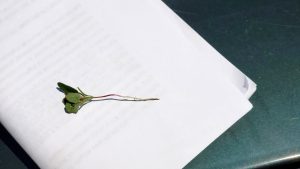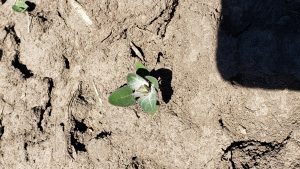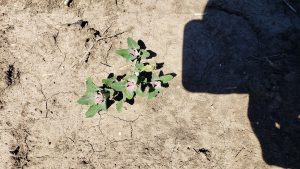Scientific name: Chenopodium album
Common lambsquarters is originally from Eurasia. It is an aggressive weed, adapted to grow vigorously in many different climates and soils, and has been able to establish worldwide. In North America it was once grown as a vegetable crop. In Asia and Africa, it is still cultivated to use as a spinach alternative or as animal feed.
Identification: Cotyledons are linear to lanceolate. The leaf surfaces and stems of the youngest seedlings are covered with clear, shiny granules that turn into a white powdery coating (Figures 1 and 2). Common lambsquarters with a purplish powdery coating can also be found (Figure 3). Margins on young leaves are entire or have few teeth. Mature leaves are alternate, often broadly triangular with irregular, usually shallow toothed margins and are pale gray-green in color. They often fold upward along the central vein. Stems are vertically grooved with red, purple or light green stripes.
Growth habit: Erect summer annual. Can reach over three feet in height. Optimum temperatures for germination ranges from 64 to 82°F.
Reproduction: Propagates by seed. Flowers from June to September. Flowers are very small, greenish, densely grouped together into small, thick, granular clusters along the main stem and upper branches. Flowers do not have petals, only 5 green sepals. Produces as many as 176,000 seeds per plant. Seeds are circular and flattened, each 1 to 1.5 mm.
Dormancy: Seeds can persist in a dormant state in the soil for years. Dormancy increases as depth increases.
Integrated weed management:
Biological control: Common lambsquarters attracts leaf miner. Leaf miner will feed on lambsquarters but can also become a problem in the crop. Field mice, sowbugs, millipedes, crickets, slugs, and carabid beetles can feed on common lambsquarter seeds lying on the soil surface.
Cultural and mechanical practices:
- Tillage: Small, emerged common lambsquarters and other emerged weeds will be controlled. Seeds that are buried deep can be moved to the surface where they can be biologically controlled or encouraged to germinate prior to a repeated shallow cultivation event.
- Planting date: It is possible to reduce lambsquarters pressure by delaying planting from mid-May to early June after weeds have been controlled with stale seedbed practices.
- Mulching: Plastic or plant-based mulches can reduce emergence near the crop by creating a physical barrier.
- Hand-weeding or hoeing: Remove weeds before they set seeds. This practice is very labor-intensive and often only practical at low weed densities and/or low acreage situations. Higher densities should be controlled with herbicides.
- Flaming: Studies have determined that common lambsquarters is sensitive to flaming when it has just emerged. The key is to target small lambsquarters (less than 5 leaves).
Chemical control:
Common lambsquarters populations have documented resistance to Groups 2 (ALS-inhibitor) and 5 (Photosystem II-inhibitor) herbicides. Some populations have demonstrated reduced sensitivity to glyphosate. Herbicides recommendations will differ by crop, production system, and stage of crop and weed development. For more specific information on chemical control options, consult the Midwest Vegetable Production Guide at https://mwveguide.org/ and the product labels.
References
Loux, M. M., Doohan, D., Dobbels, A. F., Johnson, W. G., Young, B. G., Legleiter, T. R., & Hager, A. (2017). Weed control guide for Ohio, Indiana and Illinois.
United Soybean Board (2020). Common Lambsquarters Management Fact Sheet. Take Action Pesticide Resistance Management. Retrieved June 16, 2020, from https://www.canr.msu.edu/weeds/extension/factsheets/50737FINALFactSheetLambsquarters.pdf


